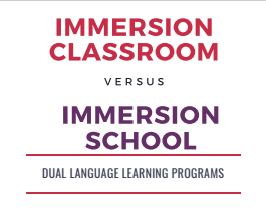Immersion Programs Availability
- Mar 4, 2020
- 2 min read

Research continues to support that dual language immersion programs are the best way to teach language and other cultures. To keep up with parent's interest in language learning for their children, some school districts now integrate dual language learning in their schools by adding immersion classrooms into their elementary schools.
Dual language immersion programs are available to families in various types. The most common available programs fall into one of the categories below:
Total Immersion– Programs in which all or almost all subjects taught in the lower grades (K-2) are taught in the foreign language;
instruction in English usually increases in the upper grades (3-6) to 20%-50%, depending on the program.
Partial Immersion– Programs in which up to 50% of subjects are taught in the foreign language; in some programs, the material taught in the foreign language is reinforced in English.
Two-Way Immersion– Programs that give equal emphasis to English and a non-English language and in which one to two-thirds of the students are native speakers of the non-English language, with the remainder being native speakers of English.
For the most part, although each program may look a bit different, they all aim to maximize language development in both languages.

Classrooms Based Programs
When a school offers immersion classes instead of a school-wide implementation the program might look a bit different. When this happens, two teachers are selected to teach as partner teachers in each grade level beginning in Kindergarten. One teacher teaches Spanish language arts, social studies, and mathematics. The other teacher focuses on English language arts and reinforces mathematics in English. As students move up in grade levels, two more teachers are selected to teach the rising grade level. This cycle continues until the students reach the highest grade level offered in the program.
School-Wide Programs
There are several differences between dual language immersion classrooms and dual language immersion schools. the main difference between them is most noted in the school-wide approach some schools take. In a school-wide immersion program, students experience language immersion not only during content area learning but also during specials such as art, music, computer, library, and physical education. Some schools offer some of their elective classes in both target languages exposing students to full immersion experience.
Most schools will call school-wide immersion programs two-way immersion programs. In a two-way immersion, model children are taught 50 percent of the day in English and 50 percent of the day in the other language, beginning in kindergarten. Students receive content area instruction in both languages. One teacher teaches language arts, social studies, and mathematics in Spanish or another language.
The timing and content taught in either language may change as the student goes up to middle school grades. Whether or not a school offers immersion in middle school depends on parent interest and continuation of the program.
I encourage you to check with your state's education website to find out where immersion programs are available in your area. You can also search the Center for Applied Linguistics for available programs listed on this nationwide website.
Download a copy of a Dual language immersion Programs Comparison Graphic



Comments